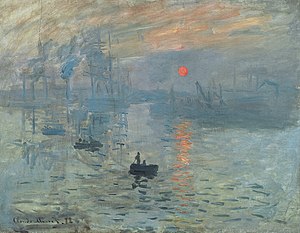 Impression, Sunrise, an 1872 Claude Monet oil on canvas painting now housed at Musée Marmottan Monet in Paris. This painting became the source of the movement's name after Louis Leroy's 1874 article, "The Exhibition of the Impressionists", satirically implied that the painting was, at most, a sketch. | |
| Location | France |
|---|---|
| Influences | Realism, Barbizon School |
| Influenced | |
Impressionism was a 19th-century art movement characterized by relatively small, thin, yet visible brush strokes, open composition, emphasis on accurate depiction of light in its changing qualities (often accentuating the effects of the passage of time), ordinary subject matter, unusual visual angles, and inclusion of movement as a crucial element of human perception and experience. Impressionism originated with a group of Paris-based artists whose independent exhibitions brought them to prominence during the 1870s and 1880s.
The Impressionists faced harsh opposition from the conventional art community in France. The name of the style derives from the title of a Claude Monet work, Impression, soleil levant (Impression, Sunrise), which provoked the critic Louis Leroy to coin the term in a satirical 1874 review of the First Impressionist Exhibition published in the Parisian newspaper Le Charivari.[1] The development of Impressionism in the visual arts was soon followed by analogous styles in other media that became known as Impressionist music and Impressionist literature.
- ^ The term "impression" indicates the direct impact of surface markers on spiritual perception or experiential cognition.Eisenman, Stephen F. (22 December 2023), "The Intransigent Artist or How the Impressionists Got Their Name", Critical Readings in Impressionism and Post-Impressionism, University of California Press, pp. 149–161, doi:10.2307/jj.8501295.10, ISBN 978-0-520-94044-4, retrieved 14 June 2024